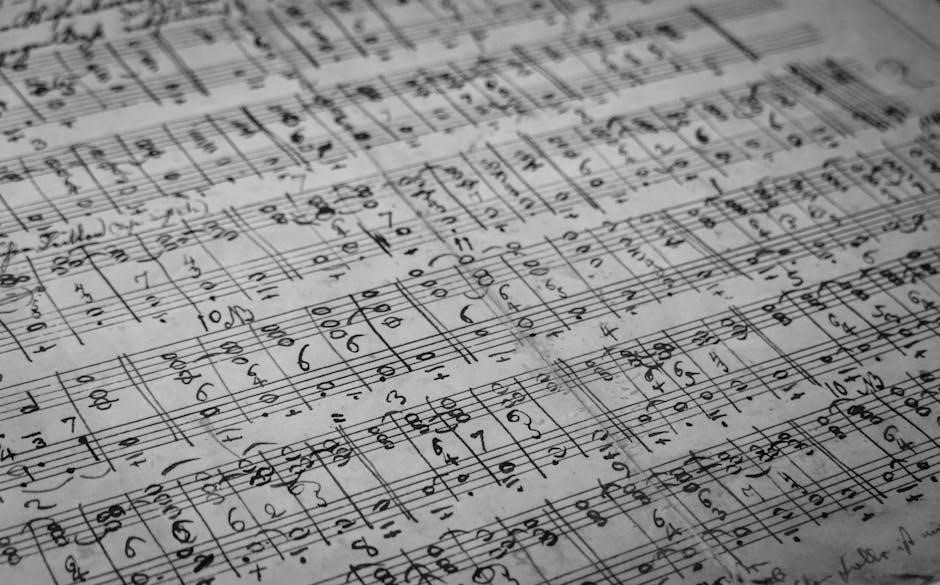Discover the world of piano playing with free sheet music featuring letter notes, perfect for beginners. Learn popular songs like “Mary Had a Little Lamb” easily with labeled keys, fostering quick progress and enjoyment. Downloadable PDFs and interactive tools make learning accessible and fun for newcomers to piano.
Overview of Free Piano Sheet Music for Beginners
Free piano sheet music with letters is a fantastic resource for beginners, offering a wide range of songs from traditional tunes like “Mary Had a Little Lamb” to simplified classical pieces such as Beethoven’s “Ode to Joy.” These sheets are designed to make learning easier by labeling notes with letters, reducing the complexity of reading standard notation. Many websites provide downloadable PDFs, including popular songs like “Ain’t No Sunshine” and Disney favorites. These resources often include finger placements and chord labels, making them ideal for those just starting their piano journey. With free access to high-quality sheets, beginners can explore various genres and styles without financial barriers, fostering a love for music and encouraging consistent practice. The availability of these materials ensures that everyone can enjoy learning to play the piano, regardless of their background or budget.
Benefits of Using Sheet Music with Letters for Beginners
Sheet music with letters simplifies learning for beginners by replacing complex notes with easy-to-read letters. This method reduces intimidation, allowing learners to focus on playing without deciphering traditional notation. Letters correspond directly to keys, aiding in understanding note placement and fostering proper finger placement. This approach builds confidence as beginners can play correctly from the start, keeping them motivated. It also enhances technique by promoting good hand positioning early on. Additionally, free accessibility ensures everyone can start learning without financial barriers, making piano education more inclusive. Overall, letter-based sheet music provides a supportive and enjoyable foundation for new pianists.
How to Read Piano Sheet Music with Letters
Reading piano sheet music with letters involves identifying notes labeled from A to G, corresponding to piano keys. Each letter represents a specific note, simplifying recognition for beginners. Start by locating middle C, a common reference point, and match letters to keys. Timing is indicated by note values: whole, half, and quarter notes. Practice playing one hand at a time, then combine. Finger placement guides often accompany the music to aid proper technique. Regular practice helps build familiarity with letter-note associations, making it easier to progress. Free PDF resources provide clear instructions, ensuring a smooth learning journey for new pianists.

Top Sources for Free Piano Sheet Music PDFs
Explore popular websites, open-source platforms, and community-driven resources offering free piano sheet music PDFs with letters for beginners. Download classics like “Ode to Joy” and “Mary Had a Little Lamb” effortlessly.
Popular Websites for Downloading Free Piano Sheet Music
Several websites offer free piano sheet music with letters for beginners. Musicnotes, Sheet Music Plus, and Free Piano Music provide a wide range of downloadable PDFs. These platforms feature simplified versions of popular songs, including Disney tunes, classical pieces, and modern hits. Websites like Piano Nanny and Easy Sheet Music cater specifically to beginners, offering labeled keys and chord diagrams. Additionally, open-source platforms such as MuseScore and IMSLP host a vast library of free sheet music. These resources are ideal for those looking to start their piano journey without financial barriers, ensuring accessible and enjoyable learning experiences.
Open-Source Platforms for Beginner Piano Music
Open-source platforms like MuseScore and IMSLP offer a vast library of free piano sheet music with letters for beginners. MuseScore allows users to download, print, and edit sheet music, while IMSLP provides a comprehensive archive of classical pieces. GitHub hosts repositories with community-contributed sheet music, often labeled with letters for ease of learning. These platforms are maintained by volunteers and music enthusiasts, ensuring a steady flow of new and accessible content. They cater to beginners by offering simplified versions of popular songs and classical compositions, making them invaluable resources for those starting their piano journey. Their open-source nature fosters collaboration and sharing, benefiting the musical community worldwide.
Free PDF Collections for Beginner Piano Songs
Websites like Musicnotes, Piano Nanny, and Free Piano Music offer extensive collections of free PDF sheet music for beginners with letter notes. These platforms provide easy-to-play versions of popular songs, classical pieces, and traditional melodies. Beginners can access arrangements of songs like “Mary Had a Little Lamb,” “Ode to Joy,” and “Ain’t No Sunshine” with labeled notes. These PDFs are designed to be user-friendly, allowing learners to print and practice instantly. Many collections are curated specifically for newcomers, ensuring a smooth transition into piano playing. These resources are invaluable for those seeking affordable and accessible ways to learn piano music with letter guidance.
Community-Driven Resources for Piano Beginners
Online communities like Piano World and Sheet Music Archive offer free piano sheet music with letters, fostering collaboration among learners. These platforms allow users to share, download, and discuss sheet music, creating a supportive environment. Many community-driven resources feature user-generated content, ensuring a diverse range of songs. Beginners can access classical pieces, folk tunes, and modern adaptations, all labeled with letter notes for easy learning. Forums and comment sections provide spaces for feedback and tips, helping newcomers improve. These community resources not only offer free sheet music but also build connections among piano enthusiasts, making the learning journey more enjoyable and collaborative.

Popular Beginner-Friendly Songs with Letters
Discover songs like Twinkle, Twinkle, Little Star and Old MacDonald Had a Farm, simplified with letter notes for easy learning. Perfect for beginners to enjoy and master quickly.
Traditional Songs for Beginners (e.g., “Mary Had a Little Lamb”)
Traditional songs like Mary Had a Little Lamb and Twinkle, Twinkle, Little Star are ideal for beginners. Their simple melodies and familiar tunes make learning fun and engaging. These songs often use only a few notes, making them perfect for practicing letter-based sheet music. The repetition and predictable structure help build confidence and finger dexterity. Many websites offer free PDF downloads of these classic pieces, complete with letter labels above the notes. This resource is especially helpful for young learners or those new to reading music. By starting with these timeless favorites, beginners can quickly experience the joy of playing recognizable songs, fostering motivation and a strong foundation for further learning.
Classical Pieces Simplified for Beginners (e.g., “Ode to Joy”)
Classical music offers timeless beauty, and simplified versions of iconic pieces like Beethoven’s Ode to Joy or Schubert’s Moment Musical are perfect for beginners. These arrangements maintain the essence of the original compositions while using fewer notes and simpler rhythms. Many free PDF resources provide letter-labeled sheet music for these pieces, making them accessible to those learning to play. For example, Beethoven’s Minuet in G and Schubert’s Moment Musical are popular choices, as they introduce classical concepts in an approachable way. These simplified versions allow beginners to enjoy the richness of classical music while building their skills and confidence. They also serve as a great introduction to the works of renowned composers, fostering an early appreciation for classical repertoire.
Modern Songs Adapted for Beginners (e.g., “Ain’t No Sunshine”)
Modern hits like Ain’t No Sunshine and other contemporary songs are now accessible to beginners through simplified sheet music with letter notes. These adaptations retain the catchy melodies and emotional depth of the originals but use fewer complex elements, making them easier to learn. Many websites offer free PDF downloads of these arrangements, allowing beginners to play their favorite modern tunes early in their learning journey. This approach not only keeps practice engaging but also helps build familiarity with modern musical styles. Additionally, these simplified versions often include chord labels, further enhancing the learning experience and making modern music approachable for new pianists.

Learning Tools and Resources
Explore apps like Skoove, video tutorials, and interactive websites offering free piano sheet music with letters. These tools provide step-by-step guidance, enhancing skill development for beginners effectively.
Apps for Learning Piano with Letter Notes
Utilize apps like Skoove, Piano Maestro, and Yousician to enhance your learning journey. These platforms offer interactive lessons, exercises, and popular songs with letter notes. Skoove provides a free course for beginners, unlocking more content with a subscription. Piano Maestro combines gamification with letter-based sheet music, making practice engaging. Yousician uses exercises and popular songs to teach piano with letter labels. These apps are ideal for tracking progress, improving timing, and staying motivated. They cater to all skill levels, ensuring a fun and effective learning experience for those using free piano sheet music with letters.
Video Tutorials for Beginners Using Letter-Based Sheet Music
Enhance your learning with video tutorials designed for beginners using letter-based sheet music. Platforms like YouTube offer extensive libraries of tutorials, such as those by Piano Lessons On The Web and HDpiano. These videos guide you through popular songs like “Ode to Joy” and “Mary Had a Little Lamb,” using letter notes for clarity. Tutorials often include slow demonstrations, finger placement tips, and practice exercises. They are perfect for visual learners, helping you understand rhythm and timing. Many channels also provide free PDF downloads of the sheet music, making it easier to follow along. These resources are invaluable for mastering letter-based piano music.
Interactive Websites for Practicing Piano with Letters
Interactive websites like Piano Marvel and Note Rush offer engaging tools for practicing piano with letter-based sheet music. These platforms provide virtual keyboards, allowing beginners to practice without an actual piano. Many sites include interactive exercises, games, and progress tracking to make learning fun. Some websites, such as Piano Nanny, combine letter-based sheet music with audio playback, enabling users to hear how the notes should sound. These resources are ideal for reinforcing lessons and improving hand-eye coordination. They often complement free PDF downloads, offering a comprehensive learning experience. Interactive websites are a great way to enhance practice sessions and build confidence in playing piano with letter notes.
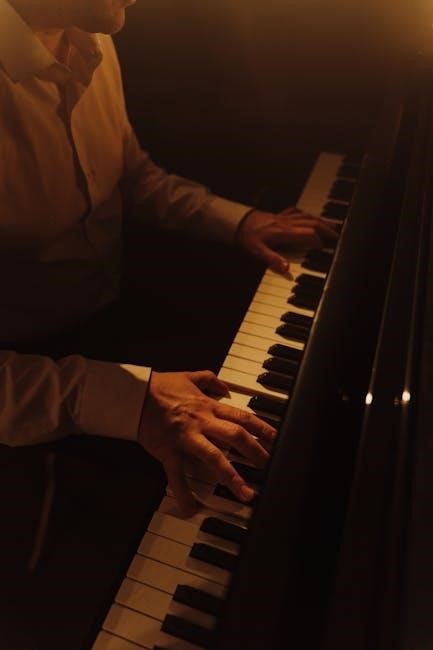
Tips for Effective Practice
Use a metronome to improve timing and play along with letter-based sheet music. Highlight tricky sections and practice hands separately before combining them for better mastery and confidence.
How to Use Metronomes for Better Timing
A metronome is an essential tool for improving timing when practicing piano with letter-based sheet music. Start by setting a slow tempo and focus on playing each note in sync with the beats. Gradually increase the speed as you become more comfortable. Use the metronome to identify and correct rhythmical errors, ensuring accuracy. It’s particularly helpful for beginners to develop a strong sense of timing early on; Many free piano sheet music PDFs include suggested metronome settings, guiding you to play at the correct pace. Regular practice with a metronome will enhance your overall musicality and coordination;
Practicing Scales and Chords with Letter Labels
Practicing scales and chords using letter-labeled sheet music is a great way to improve finger dexterity and understanding of musical structure. Start with the C Major scale, as it has no sharps or flats, making it ideal for beginners. Use free PDF resources that include letter labels to guide your practice. Begin with a slow tempo and focus on playing each note accurately. Gradually increase speed as confidence grows. Chords can also be practiced with letter labels, helping you identify root notes and intervals. This method reinforces finger placement and builds muscle memory. Regular practice with scales and chords will strengthen your foundation and prepare you for more complex pieces.

Common Mistakes to Avoid
Beginners often misread letter notes or ignore finger placement guidelines, leading to incorrect playing and potential frustration. Regular practice with proper technique is essential for progress.
Misreading Letter Notes and Key Placement
Misreading letter notes and key placement are common pitfalls for beginners using free piano sheet music with letters. One frequent mistake is confusing the note’s position on the staff with its placement on the keyboard, leading to incorrect finger placement. Additionally, some learners may misinterpret letter labels, especially when notes are in different octaves or accidentals are involved. To avoid these errors, it’s crucial to practice sight-reading and familiarize yourself with the piano layout. Using visual aids, such as labeled key diagrams, can also help reinforce note positions and improve accuracy. Regular practice and slow, deliberate playing can mitigate these issues effectively.
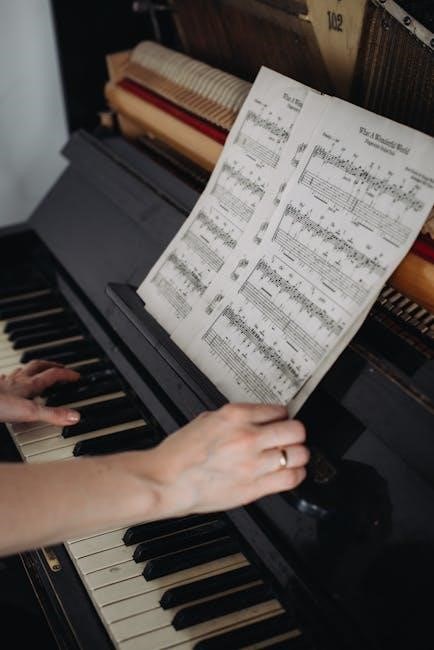
Ignoring Finger Placement Guidelines
Ignoring finger placement guidelines is a common mistake that can hinder progress for beginners using free piano sheet music with letters. Proper finger placement ensures proper note execution, dynamics, and control. Neglecting this can lead to poor technique, strain, and difficulty in playing more complex pieces. Many beginners overlook finger numbers provided in sheet music, which are crucial for developing muscle memory and hand coordination. Over time, this can result in awkward hand positioning and unnecessary tension. To avoid this, always pay attention to finger labels and practice exercises that reinforce proper placement, helping you build a strong foundation for future learning and enjoyment of piano playing.
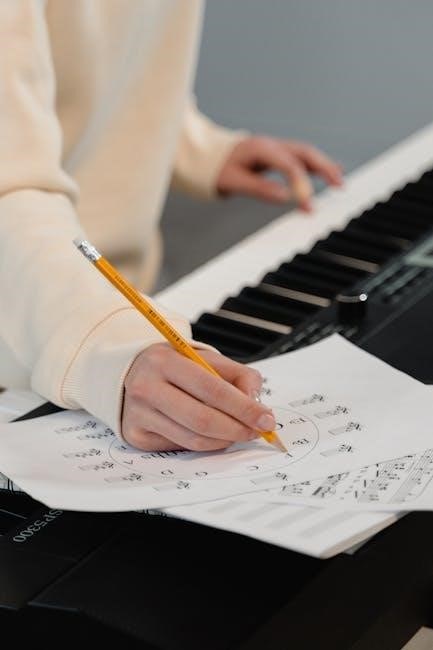
Building a Daily Practice Routine
Consistency is key! Set a daily schedule, even for short sessions, to practice piano using free sheet music with letters. Start with warm-ups, then focus on specific songs, gradually increasing difficulty as you progress. Use metronomes to improve timing and incorporate finger exercises to enhance dexterity. Track your progress and celebrate small achievements to stay motivated. A well-structured routine helps build confidence and accelerates learning, ensuring steady improvement in your piano-playing skills over time.
Creating a Schedule for Consistent Learning
Establishing a daily practice routine is essential for steady progress. Begin with short, manageable sessions of 15–30 minutes, gradually increasing as skills improve. Start with warm-ups like scales or simple exercises, then focus on specific songs from free piano sheet music with letters. Allocate time for technique practice, such as finger placement and timing, using tools like metronomes. Set achievable goals for each session, such as mastering a new section of a song. Track progress in a journal to stay motivated. Consistency reinforces muscle memory and builds confidence, ensuring steady improvement. Adjust the schedule as needed to maintain enjoyment and avoid burnout.
Setting Achievable Goals for Each Practice Session
Define clear, achievable goals for each practice session to maintain motivation and track progress. Start with simple objectives, such as mastering five notes or a short melody from free piano sheet music with letters. Break songs into smaller sections, focusing on one part at a time. Use free PDF resources to guide your learning and ensure consistency. Celebrate milestones, like completing a piece, to build confidence. Adjust goals as skills improve, gradually increasing difficulty. Setting realistic targets helps prevent frustration and keeps practice sessions productive and enjoyable. This structured approach ensures steady growth and a positive learning experience for beginners.

The Importance of Community and Motivation
Engaging with online forums and communities fosters motivation and provides support for beginners learning piano. Sharing progress and receiving feedback from peers enhances the learning experience and keeps players inspired.
Joining Online Forums for Piano Beginners
Online forums are invaluable for piano beginners, offering a supportive community to share progress, ask questions, and gain feedback. These platforms provide access to free sheet music with letters, helping learners master songs like “Mary Had a Little Lamb” and “Ode to Joy.” By engaging with fellow beginners, players stay motivated and inspired, fostering a collaborative environment that enhances their musical journey. These forums also serve as hubs for discovering new resources and tips, making the learning process enjoyable and rewarding for those starting out with piano.
Sharing Progress and Getting Feedback
Sharing your piano progress with online communities or teachers is a powerful way to improve. By uploading recordings or performances, beginners can receive constructive feedback to refine their skills. Many forums and platforms allow users to post their interpretations of free sheet music with letters, fostering a supportive environment. This interaction helps identify areas for improvement and builds confidence. Additionally, sharing achievements motivates learners to stay consistent and celebrate milestones. Feedback from experienced musicians or peers can provide new insights, ensuring steady progress in mastering piano pieces like “Mary Had a Little Lamb” or “Ode to Joy.” Regular sharing also enhances learning accountability and joy.
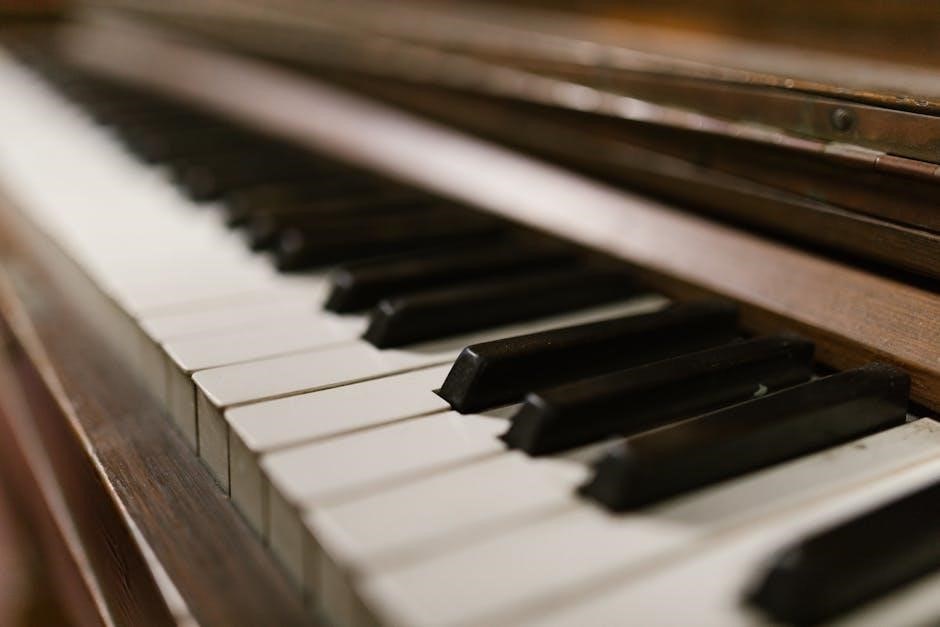
Next Steps After Mastering Basics
After mastering basics, explore intermediate-level sheet music and gradually transition to standard notation without letters, expanding your repertoire and refining your skills with more complex pieces.
Exploring Intermediate-Level Sheet Music
Once you’ve mastered the basics, intermediate-level sheet music offers a natural progression. These pieces introduce more complex rhythms, chords, and dynamics, helping you refine your technique. Popular choices include classical works like Beethoven’s “Minuet in G” or Schubert’s “Moment Musical,” simplified yet challenging enough to enhance your skills. Many websites offer free PDF downloads of intermediate-level music, ensuring accessibility. Transitioning to this level allows you to explore a wider repertoire, from folk tunes to contemporary adaptations. Practice these pieces to build confidence and prepare for more advanced compositions. This step is crucial for developing a deeper understanding of music theory and performance.
Transitioning to Sheet Music Without Letters
Transitioning to sheet music without letters is a significant milestone for piano learners. While letter-based music simplifies learning, standard notation enhances musical understanding. Start by recognizing common symbols like note values, rests, and dynamics. Practice sight-reading simple pieces gradually, using metronomes to improve timing. Resources like Skoove offer structured lessons to ease this transition. Finger placement becomes more critical, so pay attention to finger numbers. Over time, you’ll develop the ability to read music fluently, expanding your repertoire. This step builds confidence and prepares you for more complex compositions, fostering a deeper connection with music theory and performance.

